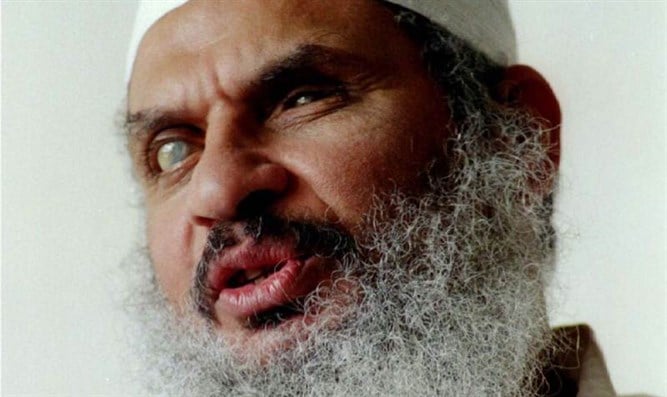Sheik Omar Abdel-Rahman, a blind Egyptian cleric who died in prison Saturday, was convicted in 1995 along with nine followers of a conspiracy to blow up the United Nations, FBI offices, highway tunnels and other New York-area landmarks in a single day.
Omar Abdel-Rahman, the Muslim cleric known as “the blind sheikh” who was convicted of conspiracy in the 1993 World Trade Centre bombing and of planning a broader “war of urban terrorism” in the United States, died on Saturday in a North Carolina prison, authorities said.
Abdel-Rahman, 78, died of natural causes at a medical centre at a federal prison compound in Butner, North Carolina, according to Greg Norton, a spokesman.
The cleric, who had diabetes and coronary artery disease, had been incarcerated at the complex for nearly 10 years, Norton said.
Earlier, the cleric’s son Ammar said his family had received a phone call in Egypt from a US representative saying that his father had died.
The Egyptian-born Abdel-Rahman remained a spiritual leader for radical Muslims even after more than 20 years in prison.
With his long grey beard, sunglasses and red-and-white clerical cap, the charismatic Abdel-Rahman was the face of radical Islam in the 1980s and 1990s. He preached a fiery brand of Islam that called for the death of people and governments he disapproved of and the installation of an Islamic government in Egypt. His following was tied to killings and bomb attacks around the world.
“Abdel-Rahman was at the vortex of some of the bloodiest and most consequential terrorist incidents of the 1990s – incidents that would establish the patterns of global terrorism that continue to bedevil us today,” said Bruce Hoffman, a terrorism expert at Georgetown University in Washington.
Abdel-Rahman, who was born in a village along the Nile on May 3, 1938, lost his eyesight due to childhood diabetes and grew up studying a Braille version of the Koran.
As an adult he became associated with the militant group Gamaa Islamiya and was imprisoned and accused of issuing a fatwa leading to the 1981 assassination of Egyptian president Anwar Sadat, against whom he had railed for years.
The sheikh said he was hung upside-down from the ceiling, beaten with sticks and given electric shocks while held but he was eventually acquitted and went into self-imposed exile in 1990.
He managed to get to New York after the US embassy in Sudan granted him a tourist visa in 1990 – despite the fact that he was on the State Department’s list of people with ties to terror groups.
US authorities blamed a computer error for the visa, but the mistake was compounded in 1991 when Abdel-Rahman was given a green card and permanent resident status. The New York Times reported that the CIA had approved the visa application for Abdel-Rahman, who had supported the anti-Soviet mujahideen in Afghanistan during the 1980s.
Abdel-Rahman preached his radical message and lived in Brooklyn and New Jersey, building a strong following among hardline Islamists. Even in exile he remained a force in the Middle East, where followers listened to cassette tapes and radio broadcasts of his sermons decrying the Egyptian government and Israel.
Abdel-Rahman and his disciples would be linked to the 1990 slaying in New York of militant far-right rabbi Meir Kahane, the 1992 killing of an anti-Islamist writer in Egypt and attacks on foreign tourists in Egypt.
US authorities took action in 1992 by revoking Abdel-Rahman’s green card on the grounds that he had lied about a bad cheque charge in Egypt and about having two wives when he entered the country.
He was facing deportation when a truck bomb went off in the basement parking garage of the World Trade Centre on February 26, 1993, killing six people and injuring more than 1000 in an attack that made Americans realise that they were not immune to international terrorism.
Four months later Abdel-Rahman was arrested and went on trial with several followers in 1995, accused of plotting a day of terror for the United States – assassinations and synchronised bombings of the UN headquarters, a major federal government facility in Manhattan and tunnels and a bridge linking New York City and New Jersey.
The indictment said Abdel-Rahman and his followers planned to “levy a war of urban terrorism against the United States” to stop US support for Israel and change its overall Middle East policy.
The defendants were not directly charged with the 1993 World Trade Centre attack but were convicted of conspiring with those who did carry out the bombing.
Abdel-Rahman’s convictions also included plotting to kill Egyptian president Hosni Mubarak during a visit to the United States in 1993, a Jewish New York state legislator and a Jewish New York State Supreme Court justice.
Much of the case against Abdel-Rahman and his followers was based on video and audio recordings made with the help of a bodyguard for the sheikh who became an FBI informant. A video also showed four defendants mixing fertiliser and diesel fuel for bombs.
After a nine-month trial, the sheikh and nine followers were found guilty in October 1995 on 48 of 50 charges.
He did not testify at his trial but at a sentencing hearing Abdel-Rahman gave a passionate speech of more than 90 minutes through a translator, proclaiming his innocence and denouncing the United States as an enemy of his faith.
“This is an infidel country,” Abdel-Rahman said in his rambling speech. “It has an infidel White House. It has an infidel Congress. It has an infidel Pentagon. And this is an infidel courthouse.”
In 2006 one of Abdel-Rahman’s lawyers, Lynne F. Stewart, was sentenced to 28 months in prison for helping smuggle messages from the cleric to his Gamaa Islamiya followers in Egypt. She began serving the sentence in 2009, was resentenced in 2010 – to 10 years – but was released in 2013 for health reasons.
In 2012, then Egyptian president Mohamed Morsi called for Abdel-Rahman to be transferred to Egypt for “humanitarian reasons” as part of a prisoner exchange with the United States. The request was denied.
Reuters, Washington Post

















